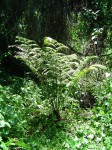Deparia boryana (Willd.) M. Kato
Synonyms |
Dryoathyrium boryanum (Willd.) Ching |
|---|---|
Common name |
|
Description |
Rhizome erect, ascending or horizontal with upturned apex, with a short caudex; rhizome scales narrowly ovate in outline, apex gradually tapering to a point, (sub)entire, 5-12 x 5-7 mm, pale brown. Fronds monomorphic, tufted, arching, 0.6-2 m tall, herbaceous. Stipe up to 1 m long, strawcoloured, smooth except for pale brown scales similar to those of the rhizome near the base. Lamina 3-pinnate to 4-pinnatifid, up to 1.2 m × 0.7 m, narrowly ovate in outline, basal pinnae hardly reduced; pinnae shortly petiolate, oblong-lanceolate in outline, apex gradually tapering to a point, 13-44 x 7-22 cm, divided into 15-20 pairs of pinnules, basal pinnules somewhat reduced; pinnules subsessile, oblong-acuminate in outline, base truncate, 3-12.5 x 0.8-3 cm, 2-pinnatifid, cut to the costules into narrowly oblong, rounded secondary pinnules, margins deeply serrate-crenate, glabrous on both surfaces, except for minute, scattered, brown hairs on costules and veins; veins free; rhachis pale brown. Sori 4-13 per lobe, round, 0.6 mm in diameter; indusium minute or up to 0.8 mm wide, (sub)entire, circular, membranous. |
Notes | |
Derivation | boryanum: named after a French botanist, J.B.M. Bory de St. Vincent (1780-1846). |
Habitat | Deeply shaded streambanks in wet evergreen forest, often where there is a break in the canopy thus allowing slightly more light; also in bamboo zone and in mist forest. |
Distribution worldwide | Paleotropic |
Distribution in Africa |
Cameroon, Dem. Republic of Congo, Equatorial Guinea (incl. Bioko), Ethiopia, Ivory Coast, Kenya, Liberia, Malawi, Mozambique, Nigeria, Rwanda, Tanzania , Uganda, Zimbabwe. |
Growth form |
Terrestrial. |
Literature |
|
